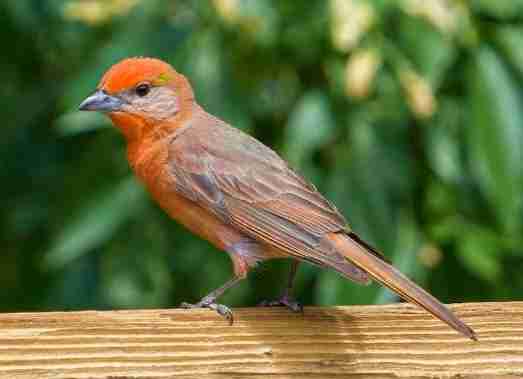The southwestern region of the United States is home to a diverse array of bird species, including several species of herons.
These majestic birds, such as the Great Blue Heron, Great Egret, and Green Heron, can be found in the arid landscapes of Arizona.
With their long necks, slender bodies, and unique hunting techniques, herons have adapted to thrive in this challenging environment.
In this article, we will explore the different heron species that call Arizona home and delve into their fascinating behaviors and characteristics.
Key Takeaways
- Great Blue Heron, Great Egret, Green Heron, Black-crowned Night-Heron, Snowy Egret, Little Blue Heron, Cattle Egret, Yellow-crowned Night-Heron, Tricolored Heron, and Reddish Egret are all species of herons found in Arizona.
- Herons in Arizona can be found in various habitats such as marshes, wetlands, estuaries, and coastal regions.
- Some heron species in Arizona form large colonies and construct nests in trees or shrubs near water bodies.
- The population of certain heron species in Arizona, such as the Tricolored Heron, is declining due to habitat loss and degradation.
Great Blue Heron

In the arid landscapes of Arizona, a notable population of six Great Blue Herons has been observed nesting near the Verde River. These majestic birds can reach a height of 4.5 feet and have a wingspan of up to 6.6 feet. They are characterized by their striking blue-gray plumage, long neck, dagger-like bill, and yellow eyes. Great Blue Herons are highly adaptable and can be found in a variety of habitats, including marshes, swamps, rivers, and shores. They are skilled hunters, using their sharp bill to catch fish, amphibians, and even small mammals. Their nests, built high in trees, consist of large stick platforms where they lay their eggs.
The Great Blue Heron (Ardea herodias) is a large, wading bird belonging to the heron species in Arizona. The presence of the Great Blue Herons in Arizona showcases the region’s diverse and rich avian biodiversity.
Great Egret
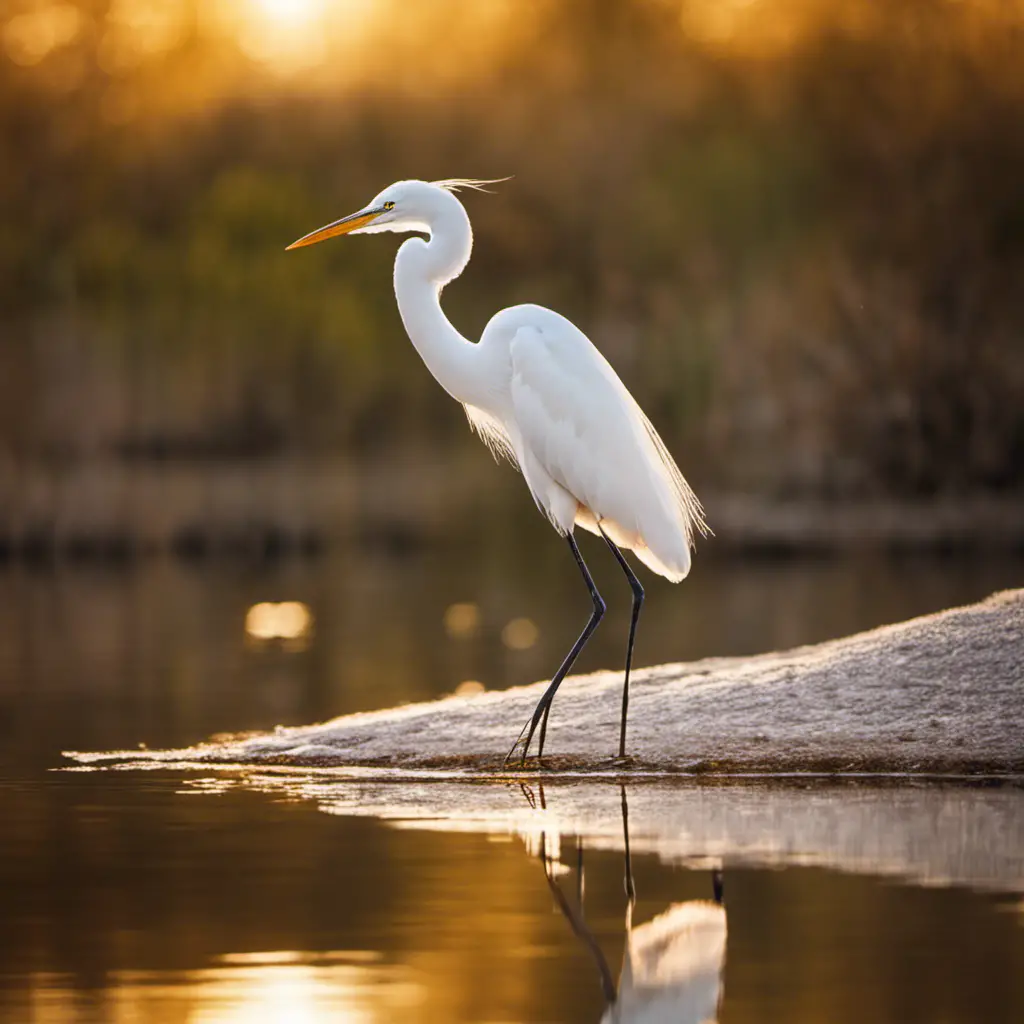
Regally perched on the riverbank, the Great Egret elegantly surveys its surroundings, showcasing its sleek white plumage and graceful stature.
The Great Egret, also known as Ardea alba, is a large wading bird found in wetland habitats across North America. Its breeding habits are fascinating, as they form large colonies and construct nests in trees or shrubs near water bodies. These nests are often shared with other heron species, such as the Great Blue Heron.
The conservation efforts for the Great Egret have been successful, as their populations have rebounded in recent years. These efforts include habitat conservation, protection of nesting sites, and regulation of hunting. Despite these positive outcomes, continued monitoring and conservation efforts are necessary to ensure the long-term survival of this majestic bird.
Green Heron
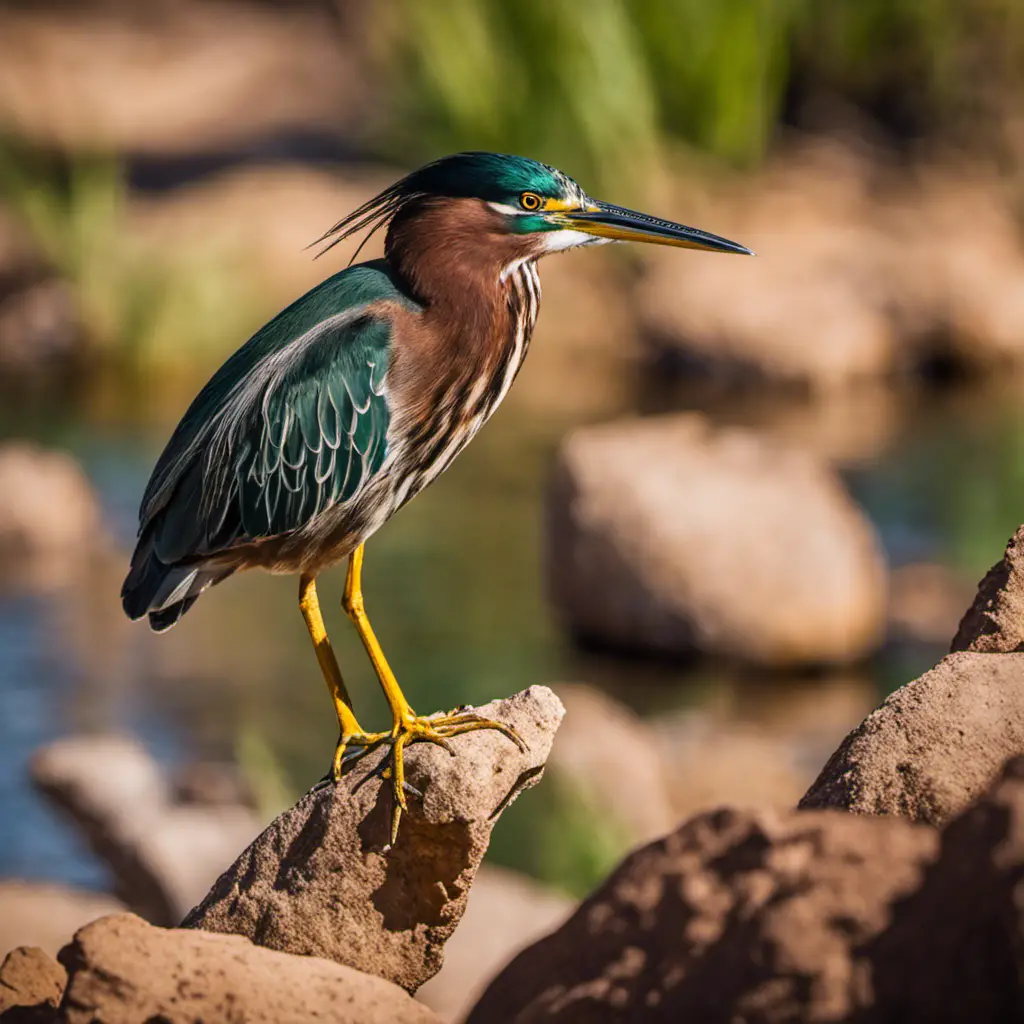
The Green Heron, though smaller in size than the Great Egret, exhibits remarkable stealth and patience while hunting for prey along the water’s edge. This species of heron can be found in various habitats across North and Central America, including wetlands, marshes, and wooded areas near water bodies.
For birdwatchers interested in observing the Green Heron, here are some helpful tips:
Look for them near water: Green Herons prefer to hunt in or near bodies of water, such as ponds, streams, and rivers.
Observe their hunting behavior: These herons use a variety of hunting techniques, including standing still and waiting for prey to approach, or using bait such as insects or small objects to lure fish.
Be patient: Green Herons are known for their patience and can remain motionless for long periods while waiting for an opportunity to strike.
Look for their distinctive features: Green Herons have a dark greenish-black back, a chestnut-colored neck, and a black cap on their head. They also have a long, sharp bill for catching prey.
Black-crowned Night-Heron
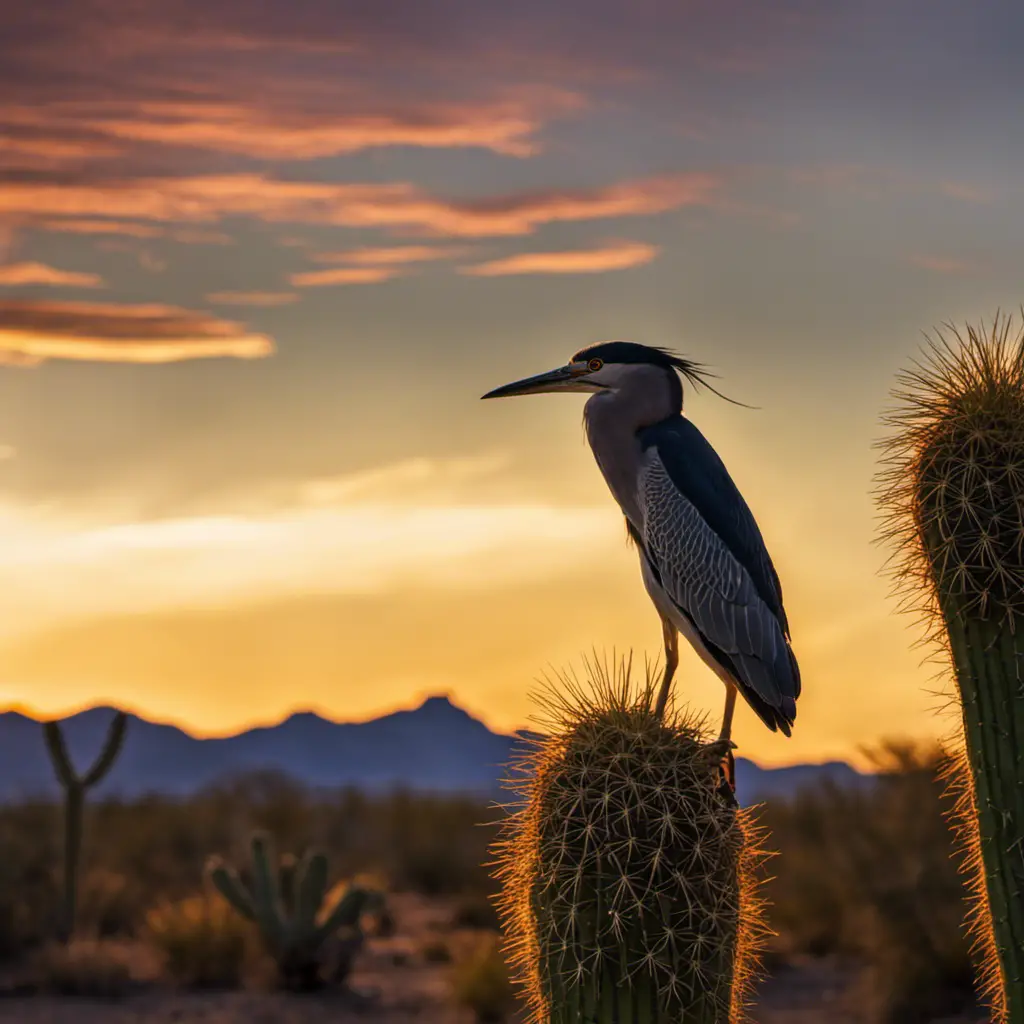
Occasionally, Black-crowned Night-Herons can be spotted foraging for food in the shallow waters of Arizona’s wetlands and marshes. These elegant birds, scientifically known as Nycticorax nycticorax, are primarily nocturnal and can be recognized by their black crown and red eyes. They have a diverse diet, consisting of fish, amphibians, crustaceans, and even small mammals. Their feeding behavior is fascinating to observe, as they patiently stand still and wait for their prey to come within striking distance, before using their sharp bill to capture it.
When it comes to nesting, Black-crowned Night-Herons prefer to build their nests in dense vegetation, such as trees or shrubs near water bodies. They often gather in colonies, with multiple nests located close to each other. Both males and females take part in constructing the nest, which is made of sticks, leaves, and other plant materials. The female typically lays a clutch of 3 to 5 eggs, which are incubated by both parents for about a month before hatching. Overall, the Black-crowned Night-Heron is a fascinating species with unique nesting habits, diet, and feeding behavior.
| Nesting Habits | Diet | Feeding Behavior |
|---|---|---|
| Build nests in dense vegetation near water | Fish, amphibians, crustaceans, small mammals | Patiently waits and strikes prey with sharp bill |
Snowy Egret
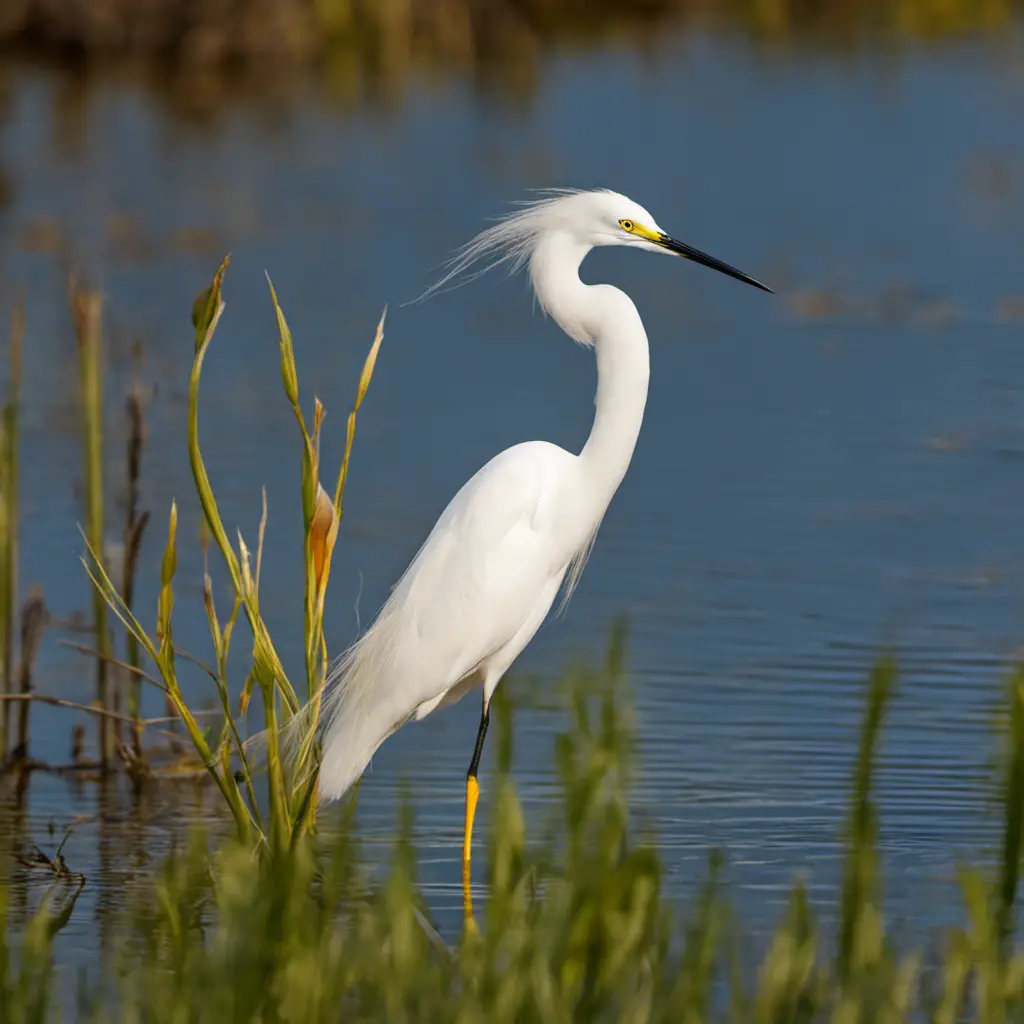
Snowy Egrets are known for their graceful hunting technique, gracefully stalking their prey in shallow waters before swiftly striking with their sharp beaks. These elegant birds have fascinating nesting habits and feeding behaviors that contribute to their survival and success. Here are four key aspects of their behavior:
Nesting habits: Snowy Egrets build their nests in colonies, often alongside other bird species. They prefer nesting in trees or shrubs near water, where they can easily access their food sources. The nests are constructed using sticks and twigs, lined with softer materials such as leaves and feathers.
Feeding behavior: Snowy Egrets are opportunistic feeders, capturing a variety of prey including fish, frogs, insects, and small crustaceans. They employ a range of hunting techniques, including standing still and waiting for their prey to come close, as well as actively chasing and stabbing their targets.
Foraging in groups: Snowy Egrets often forage in groups, forming a line and moving together to disturb small aquatic creatures. This cooperative hunting strategy allows them to maximize their food intake and increases their chances of success.
Dietary adaptability: Snowy Egrets are capable of adjusting their feeding behavior and diet based on the availability of prey. They are known to switch between different habitats and food sources, ensuring their survival even in challenging environments.
Understanding the nesting habits and feeding behavior of Snowy Egrets provides valuable insights into their ecological role and helps in formulating conservation strategies to protect their populations and habitats.
Little Blue Heron
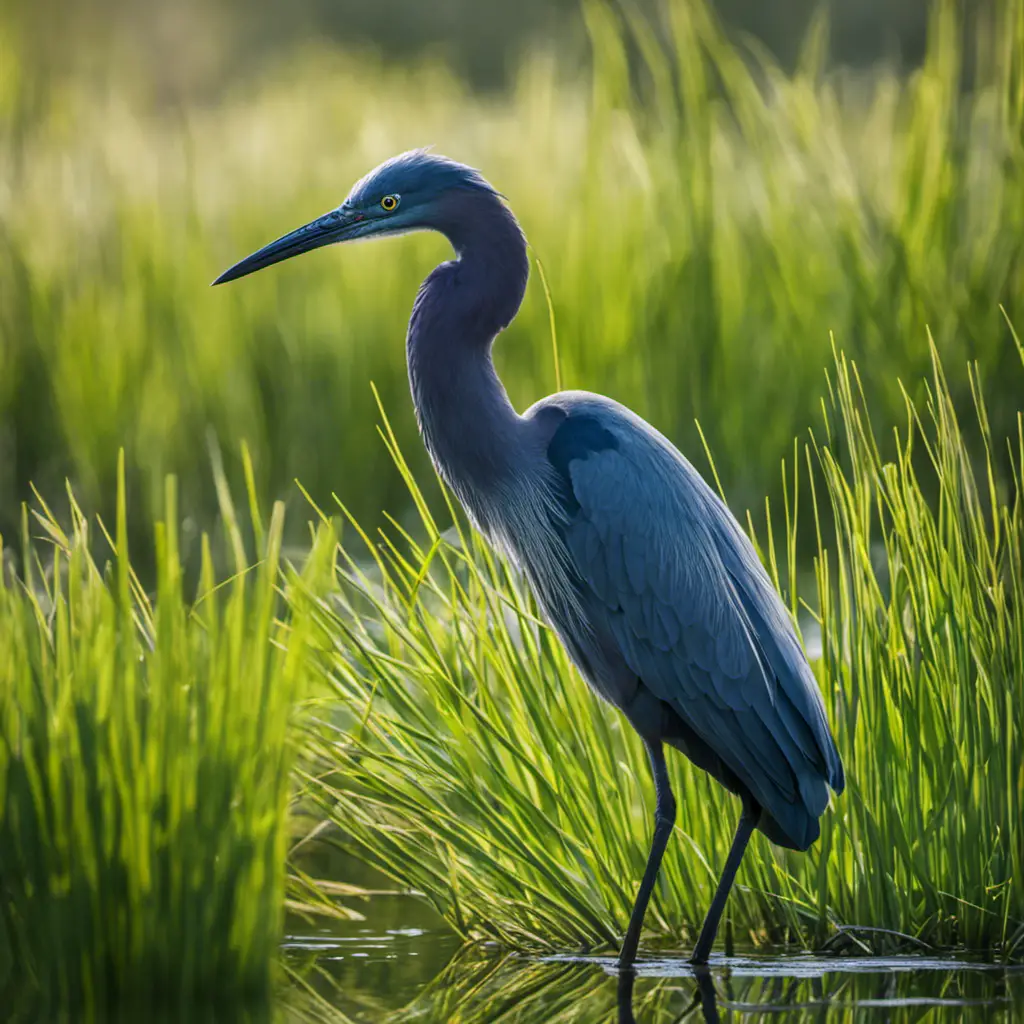
Little Blue Heron, though smaller in size, shares similar foraging techniques with its larger counterparts such as the Snowy Egret. This wading bird can be found in various habitats including marshes, swamps, and estuaries along the eastern coast of the United States and parts of Central and South America. The Little Blue Heron has a distinct appearance, with a blue-gray body and a purple head and neck during breeding season. It is important to note that juveniles have a white plumage, which can be confusing for identification. To help differentiate between the adult and juvenile Little Blue Heron, the table below provides some identification tips:
| Adult Little Blue Heron | Juvenile Little Blue Heron |
|---|---|
| Blue-gray body | White body |
| Purple head and neck | White head and neck |
| Yellow eyes | Blue eyes |
Understanding the Little Blue Heron’s habitat and range, along with these identification tips, can assist birdwatchers in correctly identifying this species in the field.
Cattle Egret
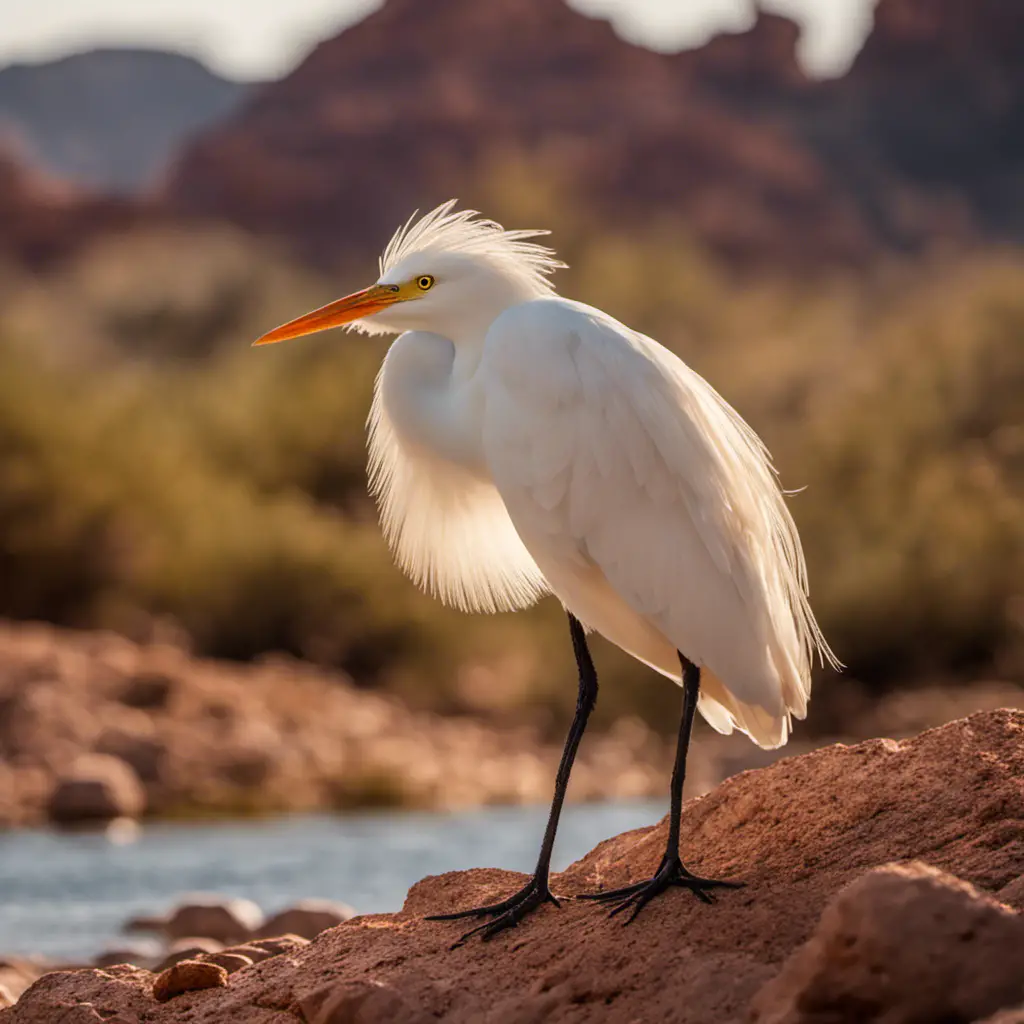
The Cattle Egret, a medium-sized heron species, is known for its ability to forage near livestock and feed on insects stirred up by their movement. This bird has a wide distribution and can be found in various habitats, including grasslands, wetlands, and agricultural fields. The Cattle Egret has distinct behaviors that contribute to its success in these habitats:
Commensalism: The Cattle Egret often follows cattle or other large mammals, taking advantage of the insects that are disturbed by their movement.
Cooperative foraging: These herons form large groups and work together to flush out insects from the grass or vegetation.
Nesting: Cattle Egrets build their nests in trees or shrubs, often in colonies with other heron species.
Migratory patterns: Some populations of Cattle Egrets undertake long-distance migrations, traveling thousands of kilometers to reach their breeding or wintering grounds.
Understanding the habitat preferences and behaviors of the Cattle Egret is crucial for conservation efforts and ensuring the survival of this fascinating species.
Yellow-crowned Night-Heron
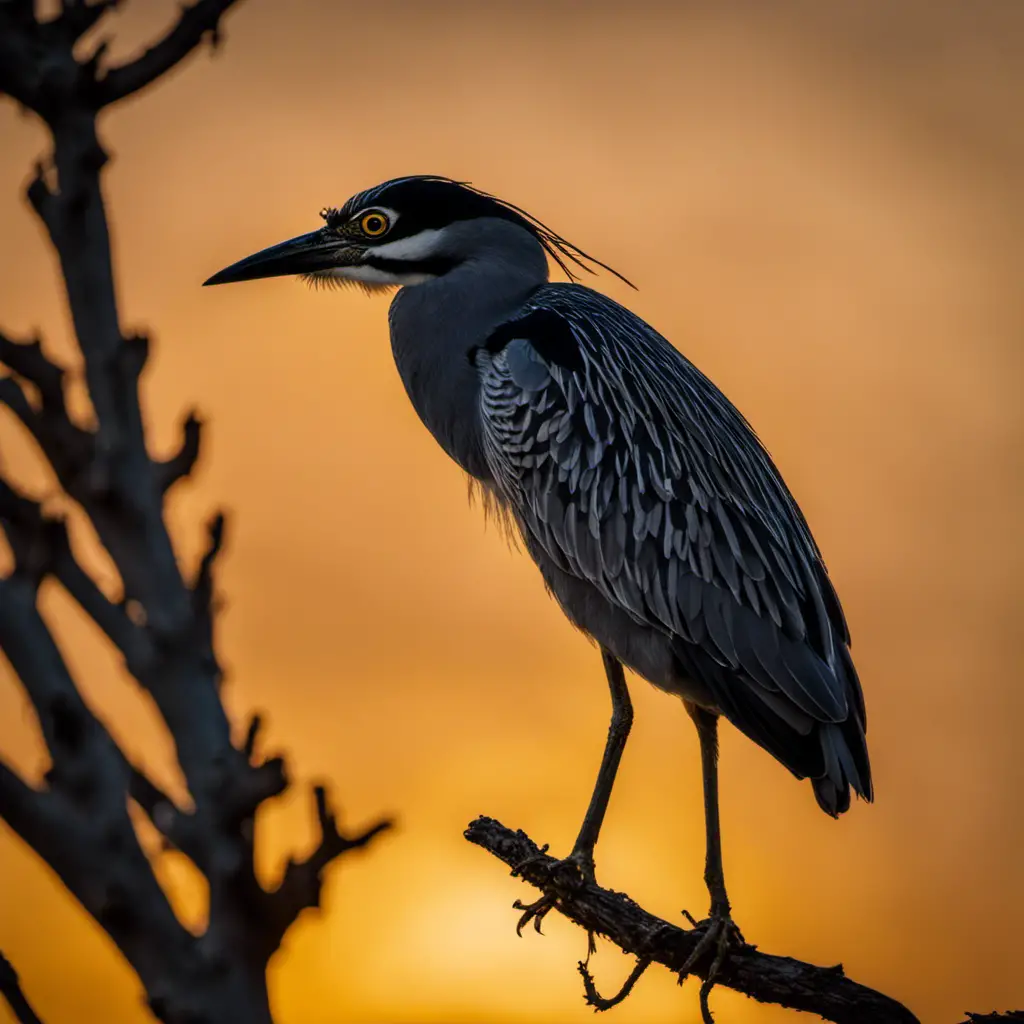
During the breeding season, Yellow-crowned Night-Herons can be found nesting in mangrove forests and other coastal habitats. These herons are known for their unique habitat and behavior. They are commonly found in wetland areas, such as marshes, swamps, and estuaries. Yellow-crowned Night-Herons feed on a variety of prey, including fish, crustaceans, insects, and small reptiles. They are nocturnal hunters, using their sharp beaks to catch their prey.
In terms of conservation status, the Yellow-crowned Night-Heron is listed as a species of Least Concern by the International Union for Conservation of Nature (IUCN). This means that the population of these herons is relatively stable and not currently at risk of extinction. However, habitat loss and degradation, as well as pollution, can pose threats to their populations. Efforts should be made to protect and conserve their coastal habitats to ensure the long-term survival of the Yellow-crowned Night-Heron.
Tricolored Heron
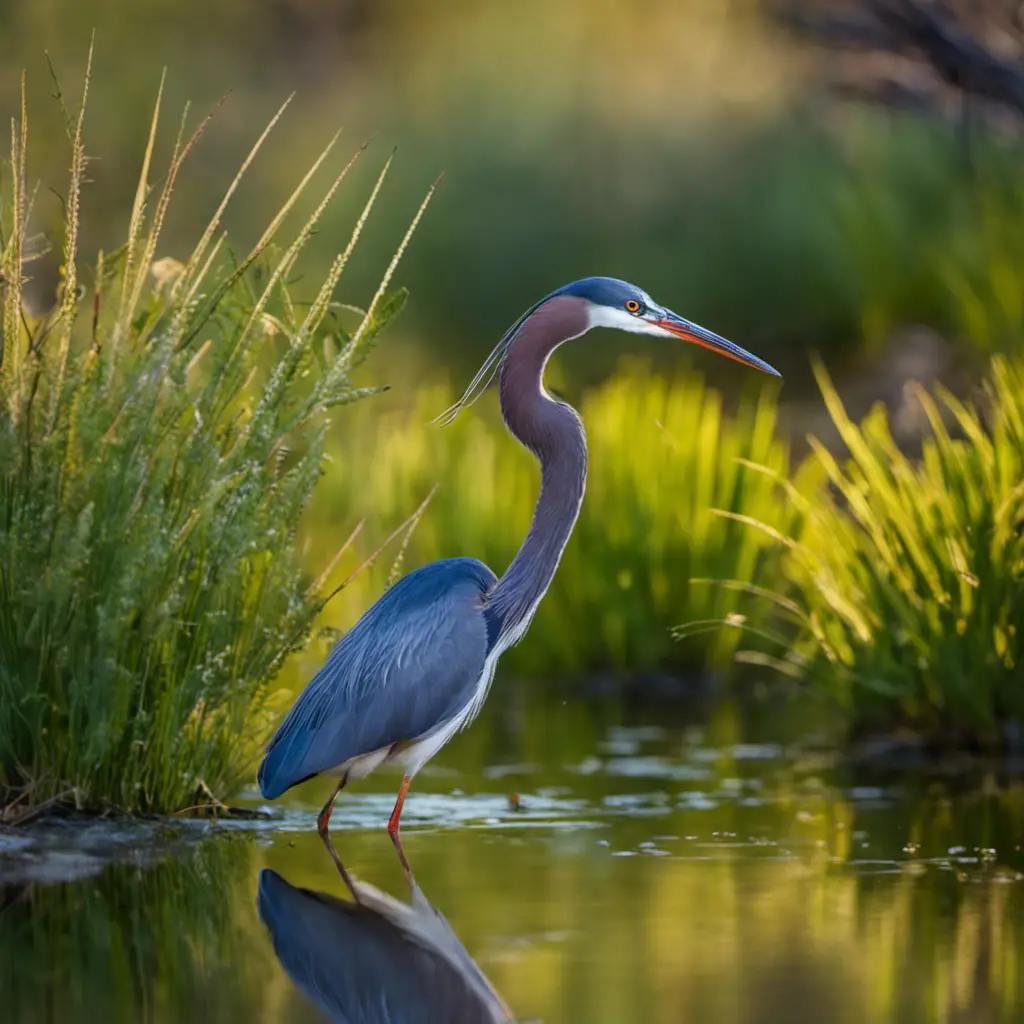
Although the Tricolored Heron is commonly found in coastal wetlands and marshes, its population has been declining due to habitat loss and degradation.
This elegant bird, scientifically known as Egretta tricolor, is known for its distinctive tricolored plumage and slender build. The Tricolored Heron is primarily a solitary bird, but can be found in small colonies during breeding season.
Behavioral patterns: Tricolored Herons are known for their graceful hunting techniques, which involve standing still or slowly walking in shallow water, and then quickly striking at fish or other small prey.
Breeding habits: During the breeding season, Tricolored Herons build their nests in trees or shrubs near water. They often engage in elaborate courtship displays, involving aerial displays and ritualized movements.
Habitat loss: The decline in Tricolored Heron populations can be attributed to the destruction of their natural habitats, primarily caused by urbanization and coastal development.
Degradation: Pollution and the introduction of invasive species also contribute to the degradation of the Tricolored Heron’s habitats, further impacting their population numbers.
Reddish Egret
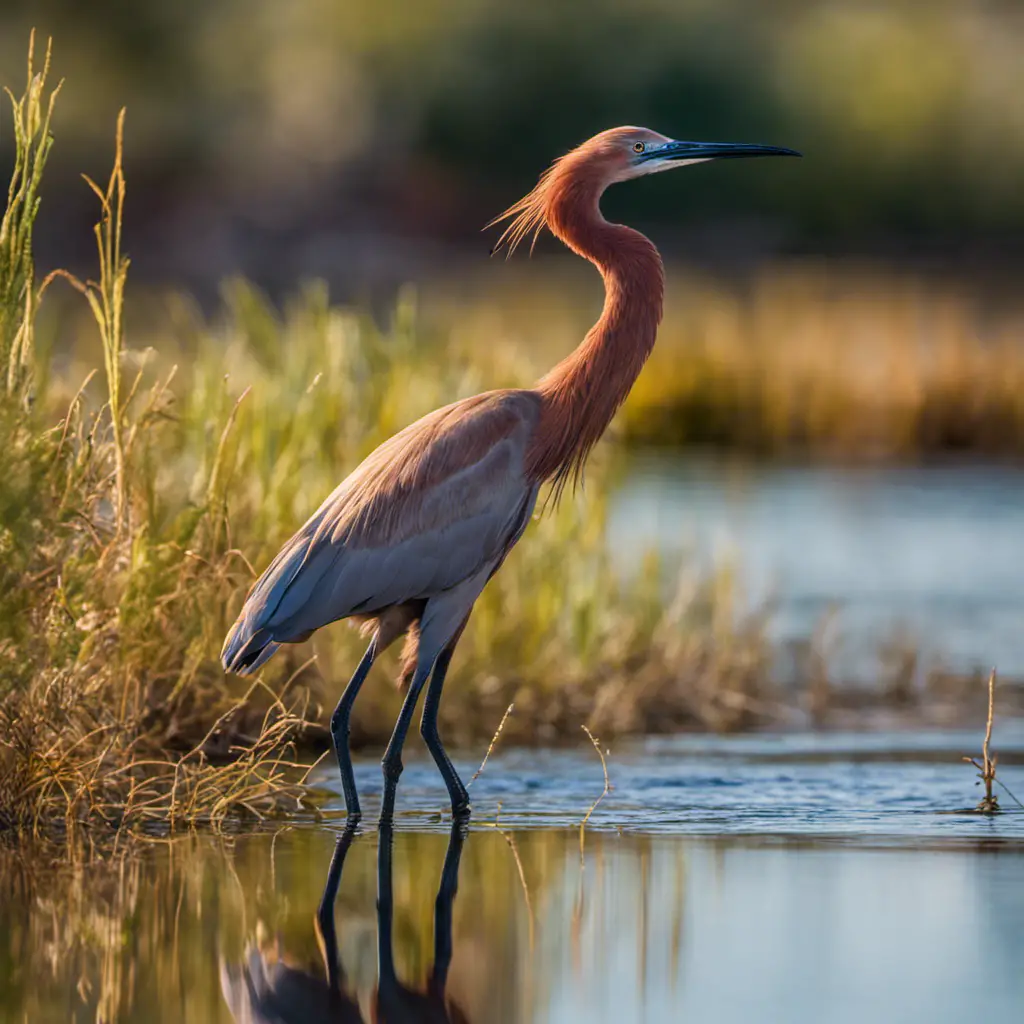
Reddish Egrets, known for their distinctive reddish plumage and unique foraging behavior, engage in an elaborate dance to startle their prey before swiftly striking. These egrets are found primarily in coastal regions and wetlands, where they prefer shallow water habitats such as mudflats, estuaries, and lagoons. Their behavior patterns include a variety of hunting techniques, including standing still and waiting for prey, running and spinning while stirring up the water to flush out prey, and using their wings to create shade to attract fish. Reddish Egrets are known to be opportunistic feeders, consuming a wide range of prey including fish, crustaceans, amphibians, and insects. Their habitat preferences and foraging behaviors make them a vital part of the ecosystem, contributing to the balance and diversity of coastal and wetland environments.
| Behavior Patterns | Habitat Preferences |
|---|---|
| Elaborate dance to startle prey | Coastal regions |
| Running and spinning to flush out prey | Wetlands |
| Using wings for shade to attract fish | Shallow water habitats |
| Opportunistic feeders | Mudflats, estuaries, lagoons |
| Consuming fish, crustaceans, amphibians, insects |
Frequently Asked Questions
What Is the Average Lifespan of Herons in Arizona?
The average lifespan of herons in Arizona varies depending on several factors such as habitat, predation, and availability of food sources. Additionally, herons possess unique hunting techniques that contribute to their survival and reproductive success.
How Do Herons in Arizona Catch Their Prey?
Herons in Arizona exhibit various feeding habits and hunting techniques to catch their prey. These include stalking, waiting patiently, and using their sharp beaks to spear fish and other small aquatic animals.
Are Herons in Arizona Considered Endangered or Threatened Species?
Herons in Arizona are not considered endangered or threatened species. However, their populations can be affected by habitat loss, pollution, and climate change. Conservation efforts are important to ensure their continued presence in the region.
Do Herons in Arizona Migrate During Certain Times of the Year?
Herons in Arizona exhibit migratory patterns, with some species migrating during certain times of the year. These patterns are influenced by various factors, including breeding habits and availability of food sources in different regions.
What Are the Main Threats to Heron Populations in Arizona?
The main threats to heron populations in Arizona include climate change and habitat loss. These factors can disrupt nesting sites, alter food availability, and impact overall population dynamics. Conservation efforts are needed to mitigate these threats and ensure the long-term survival of herons in the region.
What Species of Warblers Can Be Found in Arizona?
Arizona is home to a diverse range of warblers found in arizona, including the popular Yellow Warbler, Orange-crowned Warbler, and the rare Lucy’s Warbler. These warblers bring vibrant colors and delightful songs to the state’s diverse ecosystems, making birdwatching a cherished activity for enthusiasts in Arizona.
Conclusion
In conclusion, Arizona is home to a diverse range of heron species. These majestic birds can be found in various habitats across the state, displaying unique characteristics and behaviors.
The heron species found in Arizona include the Great Blue Heron, Great Egret, Green Heron, Black-crowned Night-Heron, Snowy Egret, Cattle Egret, Yellow-crowned Night-Heron, Tricolored Heron, and Reddish Egret.
Their presence contributes to the rich biodiversity of Arizona’s avian population and highlights the importance of preserving their habitats for future generations to appreciate and study.

An avid ornithologist, zoologist and biologist with an unwavering passion for birds and wild animals.
Dr. Wilson’s journey in ornithology began in childhood and led him to obtain a Ph.D. in Ornithology from the prestigious Avian Research Institute. He has worked closely with renowned experts in the field and conducted extensive research and field studies globally.




